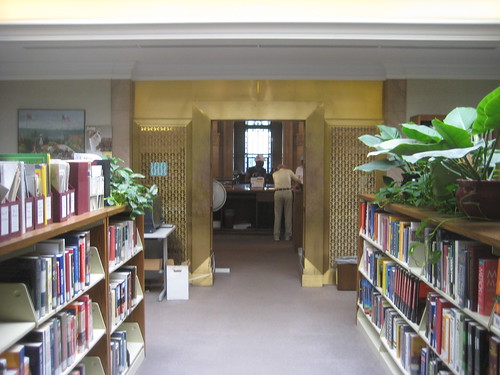
This past June the St. Louis Central Library designed by Cass Gilbert closed for a $79 million dollar renovation which is scheduled to be complete for the building's 100th birthday in 2012. The renovation will restore historic ceilings that were altered to install fluorescent and recessed can lighting, provide new HVAC and plumbing systems, introduce a new auditorium as well as several other improved spaces.
The week before it closed I took a brief tour of the spaces beyond the bronze doorway at central desk of the great hall. Here was housed the central stacks that while generally closed to the public contained a structural system making it possibly one of the more interesting features of the building.

Upon entering the stacks you immediately experience that made this off-limits area so interesting, the glass floors! The glass floors were designed to let natural light from the exterior windows filter deep into the rows of shelves. According to library history, when originally built the stacks had one light bulb for every other row of shelves, which meant that making every allowance for day-lighting was of great importance.
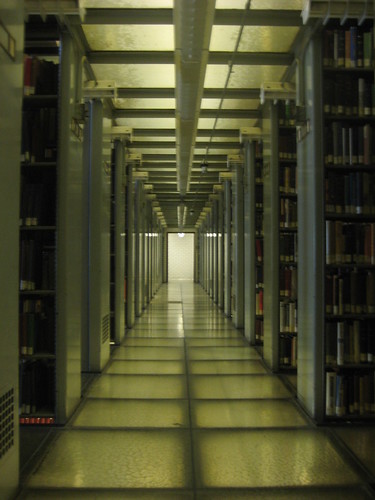
An engineering feat themselves, the stack shelves rise the full 7 levels of the stack tower and support the glass and steel floors at each level.
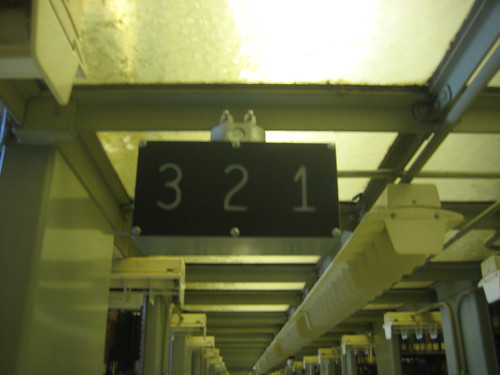
While unique to St. Louis, the Central Library's system of glass floored stacks was used in many larger municipal and university libraries in the late 19th and early 20th centuries.
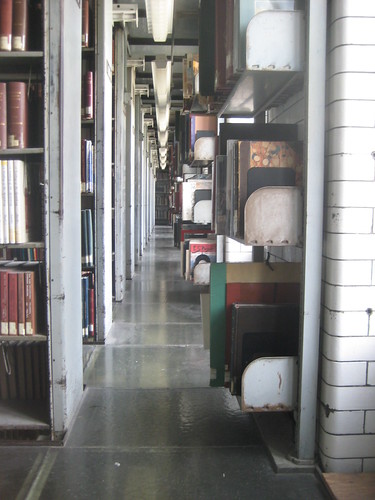
The fluorescent lights near the exterior wall are left off during the day as daylight fills the aisles.
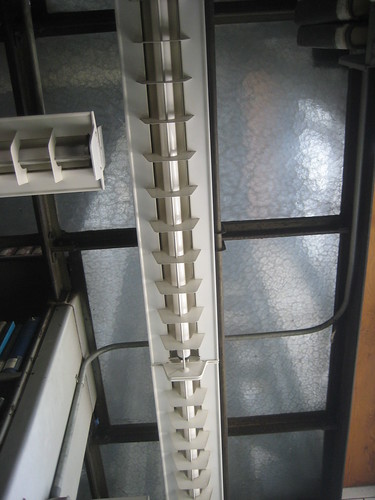
Unfortunately with the Central Library's renovation this intriguing feature will be removed to open up the former stack space for a new atrium and entrance facing Locust Street. The library already has two original accessible grade level entrances on Locust Street, so why a third is needed is to me beyond comprehension.
Those who argued for eliminating the old stack tower say that the stack tower was a fire hazard. While the design of the stack tower with openings between floors could be an issue, any time you have a high density concentration of books, you have a potential fire hazard. Employment of modern fire suppression systems are the safest and best way to prevent devastating fires.

Another feature of the Central Library that will disappear with the stacks is the pneumatic tube system.

Requests for books were presented at the central desk in the great hall and sent via the pneumatic tubes to the stacks where librarians retrieved the books and brought them to the patron at the desk.
I can understand that this system requires more employees to keep running and that there are probably other benefits to an open stack system, but having someone else find your book was pretty nice. Librarians: please weigh-in.
These dumbwaiters were used to ferry piles of books back to their appropriate level for re-shelving upon return. They will also be removed with the stack tower.
Below is a video from KETC Channel 9's Living St. Louis series that gives a good synopsis of the Central Library's history and features.
Near the end of the video are a sequence of historic photographs showing the construction of the seven story stacks and glass floors. If you could play this in reverse you can imagine how the demolition crews equipped with cutting torches will soon disassemble the stack tower, cutting the steel into pieces, tossing the glass into a dumpster and destroying this unique structure (for St. Louis) forever.



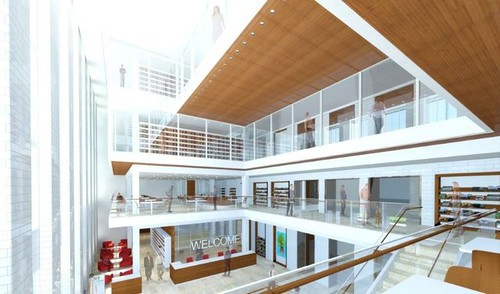
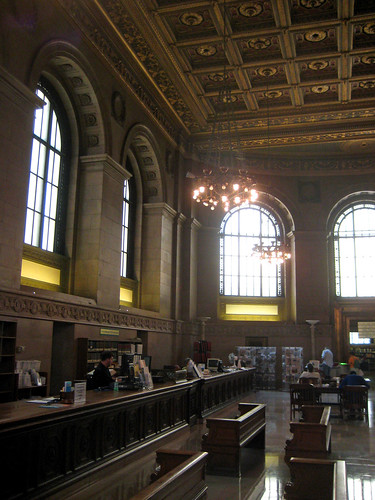
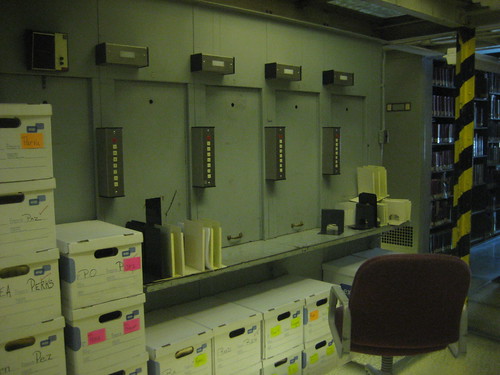
17 comments:
Good story. Love the idea of glass floors and ceilings to spread light. I never liked the book retrieval system because I love to browse library shelves. I may know the code for a book, but I do not know what similar books are around it. And what a find they sometimes are!
I heard that some of the glass was going to be recycled into the new atrium/entrance. Is that not true?
As far as I know, the nearest glass-floored library will now be the one in Jacksonville, Illinois--unless they've remodeled THAT one in the last few years. All this time, I never knew that OUR main library had 'em back in the stacks too.
Oh, and the atrium? Ridiculous.
if i take a quick glance at the new atrium it looks like it could be any entryway to any hospital office building
yech!
Darren, the Jacksonville library was indeed remodeled, during which the glass floor system was removed. The remodeled library opened in 1996. I was going to post here anyway to point out that that glass floor system was once fairly common in libraries, and not only larger libraries, witness the one in Jacksonville, population 25,000 or so.
I agree regarding the glass, but disagree completely on the issue of librarians fetching books for me.
Open stacks are so much better. People should be allowed in.
Aren't we being a little melodramatic here? The MOST interesting feature of the library? What about the amazing wood carving on the ceilings of the reading rooms, or the amazing frescoes on the ceilings of the rooms? Or the amazing alabaster light fixtures?
BTW, Closed stacks suck.
I did hear that a portion of the glass would be re-used in some way as well, but I do not know if it will be in floors or some other use.
I can't believe I'm saying this, but I agree with Darren. The atrium seems not only ridiculous but, more importantly, pointless. More of a show piece to make the Trustees look visionary, or modern...or something. One big hunk of ego right there. I understand the ADA requirements, but really. Well, at least they are going to restore the chandeliers to their old positions.
fantastic post. i had no idea.
Missouri Supreme Court Library has glass floors
Idiots! This very same system used to exist in the Lake Forest Library in Lake Forest Illinois. It was stunning...like something out of Pierre Chareau's Maison de Verre. The combination of classical architecture and good industrial design is as historically important as the "pretty" parts of these two libraries. Sadly the LF Library also gutted their glass and steel stacks in the name of progress thinking they were not as important as the rest of the Edwin Clark's Georgian/ Art Deco masterpiece.
There will still be only 2 entrances to the building. The existing entrance on the Locust street size will move to the center of the building, preventing people from walking through the Children's area all the time. Display boards of the renovation are on display at the Central Express location in the Old Post Office until the end of October.
As far as the the glass floor goes, what was cutting edge 100 years ago doesn't always work today or tomorrow. While it is nice to see it, the library will be able to serve the public better by having increased public areas as well as increased access to the materials.
I've never visited the stacks and am so glad that you've seen and documented them.
I know I've visited another library (much smaller) with a similar system if glass flooring supported by steel grid and bookstacks rising up through many floors.
I visited as part of research I was conducting for installing glass floors in one of my projects. SLU? Episcopal church archives? I'm not sure, but may have some photographs.
I wish they could keep the existing stacks and allow for open access (even if limited).
While the proposed atrium is interesting, it doesn,t seem to fit the context terribly well.
there is a similar glass floored library in baroda,India called the baroda central library which has the original glass and steel structure intact.
the building itself was built by edwin lutyens and the multi tier steel bookstack (glass floored) was manufactured by remington rand library bureau .
they now manufacture a similiar model with concrete floors.
as for it being cutting edge 100 years ago -how does it even matter if it is good design even today !the use of steel is impeccable and the very fact that this structure does not require an additional foundation is AMAZING .
im a student of architecture (in india ) doing a research thesis based on this building .
would anyone be able to suggest any possible sources for drawings of the prototype structure ?
ive managed to get a brochure from the remington rand in new york but it would be great if i could get more drawings .
The fact is, no matter how big the Great Hall is, it's far too dark for me. Opening up a whole side of the building on the other side gives patrons options. If you still like the Great Hall you can read there, but if you prefer something brighter and more open the new atrium is perfect, especially when it's too hot or too cold to read outdoors.
The closed stacks may have been a unique feature, but the average visitor wasn't allowed in, and even if you got rid of the shelves it wouldn't be a whole lot brighter than the Great Hall.
We need a living library, not yet another museum showcasing our faded past.
Post a Comment